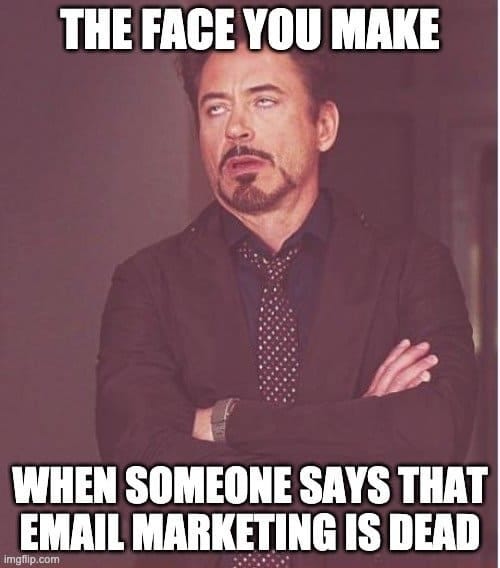This is the fourth article in Skalegrow’s series on B2B growth hacking. I suggest that you give the first three a read. Here are the links:
B2B Growth Hacking – 11 Tactics To Explore
B2B Growth Hacking Tactics To Explore – Part 2
B2B Growth Hacking Tactics To Explore – Part 3
In this blog post, we will learn 7 more B2B growth hacks that will help you stay ahead of your competition. All the growth hacks discussed are consolidated based on years of experience, learning, and research by our team. So I am sure there will be a ton of value for you in them.
That said, let’s begin.
B2B growth hacking – 7 hacks explore in 2024 and beyond
Here are the 7 B2B marketing hacks we will be covering:
- Convert video viewers into leads
- Leverage text-to-speech conversion for growth
- A common SEO tactic many don’t try
- A content type for low-cost marketing
- Get free PR! Tell your story
- Learn these tips on webinars
- Large brands use this hack to win deals!
1. Convert video viewers into leads
I have a question for you.
Do you know who viewed the videos on your website?
Okay. I am sure you don’t.
At least, do you know a small percentage of them?
I know – you don’t.
But don’t worry. I have good news for you.
What if you could convert a portion of the video viewers on your website into leads? You can further nurture them, and some of these could be your future customers.
But how is this possible? Hosting videos on the website using YouTube will only let users view the content.
So how can you achieve this?

Source: makeameme.org
By using specialized video hosting tools that come with the lead gen form feature.
These tools give you the option to add a form to a video that will require the user to enter his/her email ID to continue watching it.
You can configure the form in a way that it pops up only when the user views the video for the second time (since that indicates clear intent). You can also set the time of the video when the form appears. This helps to show the form only to users who are highly keen to consume your videos. In addition, it ensures that users are not steered away from your content.
Next, let’s come to the tools that can help you do this.
There are a few in the market. My favorites are Hippo Video and Sprout Video. Check them out to learn how they work.
But here is a caveat.
It makes sense to utilize this feature only if your website has a decent amount of traffic (and of course, it should have a lot of videos hosted). This is because, only if you have a good amount of traffic, will you have video views. Since only a small portion of the viewers will fill the lead gen form, you need a significant volume of traffic to generate a good number of leads.
2. Leverage text-to-speech conversion – an AI-based B2B growth hack
This hack is about a cool application of AI in marketing – text-to-speech (TTS) conversion.
As the term suggests, it involves converting text to natural-sounding voice-overs that can be used for various purposes such as creating video voice-overs, podcast intros and outros, etc.
Using AI to automatically convert text to voice offers the following advantages:
- Professional voice-over artists can be expensive. On average, the voice-over for a 2-3 minute video can cost anywhere between $50 to $500 depending on the language and the voice-over artist. Using a TTS tool can reduce this cost significantly (TTS tools can cost as low as $50 per year).
- It reduces the dependency on an external resource (the voice-over artist).
- TTS tools deliver the output almost instantly whereas a voice-over artist can take several days.
Now, let’s come to examples of TTS tools.
The one I think comes with the most natural-sounding voiceovers is ElevenLabs. It has already made a buzz in the market. You can try it out for free by visiting the website here.
Another one of my favorites is Speechelo, which is what I use to create some of Skalegrow’s videos (check out the below video for example):
To learn more about Speechelo, watch the below video:
So if you create a lot of video content, AI-based text-to-voice conversion is worth a try. It will ease and speed up the process of creating and publishing videos.
B2B growth hack #3 – A common SEO tactic many don’t try
We all often become too comfortable doing things we have been doing for years. Due to this, we tend to ignore certain business and growth tactics that are known to all of us. This hack is an example of such – it is nothing but updating your old content for relevant keywords and content.
You all might have noticed that some of your pages that have been ranking for a while go down in search results after a while. This is primarily because Google likes fresh content. In addition, some of your competitors would have created competing content that is taking away your position.
One of the ways to overcome this challenge is to consistently update your old content. This also helps you update relevant stats, change references to dates or years, include the latest information, improve the overall tonality, etc.
Here is the step-by-step process you need to follow for updating your old content from an SEO as well as content standpoint:
- Enter your website or page URL into an SEO tool like Ahrefs and SEMRush and find out your website’s position for some of your core keywords.
- From the list of pages, filter out those that were published within the last year.
- Now enter the core keywords of the remaining old articles into the SEO tool and go to the top 5 to 10 results. Analyze those pages for keywords and content quality (for analyzing keywords, look at the pages’ metatags and put the URL into the SEO tool).
- List down the new keywords and content perspectives you can add to your existing articles.
- The last step is to go ahead and update the content with the new keywords and content. And don’t forget to track your results using Google Search Console and an SEO tool of your choice.
According to SEO expert Neil Patel, updating old content can boost rankings. He proves this with data. So this activity is worth the effort.
4. A content type for low-cost marketing
This is a hack that you all are familiar with but probably don’t know the different ways in which you can apply it.
Can you guess what I am talking about?
It’s User-generated content.

Source: wpswings.com
For many of us, user-generated content means just case studies and reviews & testimonials.
But in reality, the scope of user-generated content goes much beyond these. Some of the other examples of user-generated content include:
- Guest posts (written by an outsider on a company’s website)
- Communities and online forums
- Collaborative webinars
- Podcasts
- Hosted events (sessions by speakers from outside)
- Social media posts (by people other than the company employees)
- Partner, distributor, and vendor promotions
- PR campaigns
Wondering how to leverage these content types for B2B growth? Don’t worry. I got you covered.
Check out the below article on this topic to learn how to implement user-generated content across different content types and campaigns:
Leveraging User-generated Content in B2B [Beyond Case Studies]
Remember, content is a long-term game. So you need to put in consistent efforts over an extended period to start seeing results from your tactics. The same applies to user-generated content as well.
5. Get free PR! Tell your story
Everyone wants to do PR. But making it to the top publishers is not easy. Even if you work with a PR agency, it’s not guaranteed that your story will get published. Unless you have connections with some of the top journalists in your space, PR becomes a tough endeavor.
But what if there is an alternative? What if there is an easier way to get access to journalists without having existing relationships?
Wondering what I am talking about?
It’s HARO – Help A Reporter.
HARO works like a marketplace that connects journalists with experts. While business leaders can use HARO to find relevant stories they can contribute to, journalists get access to a wider pool of experts.
This is how it works.
First, you register on the HARO website. You will start receiving emails daily with a consolidated set of story topics across different domains such as technology, personal finance, marketing, etc.
If you find a topic that you can contribute to (and is relevant to your business), you need to send your pitch to the email ID given talking about how you are the right person for it.
If they approve, you will be mostly sent an interview questionnaire which you need to fill out. You might also be asked to share some additional info like a photo, a link to your website, a video, etc.

Source: Pinterest
The key here is that you have to approach this like a sales pitch. The more pitches and attempts you make, the higher the likelihood of you landing a story. Make sure to put wholehearted efforts into the pitch email you write. The quality of the pitch is one of the factors that determines your success.
Using this technique, I was able to get featured in Authority magazine on the topic ‘How AI is disrupting our industry’. Check out the interview here.
Give this hack a try and let us know the results.
6. Learn these tips on webinars
Webinars are one of the best lead generation and brand awareness weapons in the B2B space. Most of us are good at hosting webinars and doing pre-webinar activities. However, the biggest gap today lies in post-webinar activities, where most companies forget about the webinar once it is concluded.
But here is the thing.
Limiting your post-webinar activities to follow-ups by your sales team is like owning a gold mine and mining it only one day a year,
Hence, I thought of covering a few tips that will help you make the best use of the webinar content once you are done hosting it.
The most common thing B2B businesses do after a webinar in terms of hosting and promoting the content is to upload it on their website and/or YouTube channel. You probably send an email to all the attendees and registrants with a link to the video and the slide deck you used. This is the absolute essential, but that’s not ENOUGH!
In addition to these, do the following:
- Cut the full webinar video into smaller videos and upload them as separate videos on YouTube and your website. If possible, create separate landing pages for each video for SEO purposes.
- Promote the videos on other platforms, especially LinkedIn (upload as native videos) and email (a newsletter is the best format for promoting educational content like webinars).
- Make sure to add subtitles to the videos. You can do this either by using YouTube’s and LinkedIn’s native transcription features or using a tool like Veed. Use the same technique to convert the long video into a blog post.
- As you cover each section in the blog post, embed the relevant individual videos you repurposed from the complete video (remember this hack we discussed in one of our previous newsletter editions?).
By doing these, you make sure that your webinar content is distributed to more people outside your registrant or attendee list. You also get multiple pieces of content created for different channels without much additional effort.
Related: Webinar Marketing – Everything You Need To Know
7. B2B growth hacking – how large brands win multi-million dollar deals
Before I get into this hack, I have a question for you.
Haven’t you felt that when many popular CEOs and leaders talk openly about powerful growth strategies, they still keep a few to themselves to ensure that their competition doesn’t crack the code that they have?
Many say that in the era of dark social and demand generation, you need to give everything away. But the truth is that gurus and thought leaders don’t reveal their biggest growth secrets. The hack I will be discussing today is one such.
This involves creating multi-touch campaigns using a combination of EMAIL and PAID ADS.

Source: Engagebay
Wondering how that is possible? I will explain.
We all know that an average B2B buyer has at least 7 to 8 (or more) touchpoints with a business before he/she even talks to the sales team. This is the reason why marketers today need to take an omnichannel approach. They need to use a combination of SEO, social media, video marketing, paid ads, email, etc., to grab the attention of prospects.
Of these, emails and ads are targeted efforts. The mistake most B2B growth marketers make is that they look at these channels in isolation. But what if you run simultaneous campaigns across these two channels targeting the same set of people and accounts?
For example, imagine that you are running an outbound email marketing campaign that is sales-driven to your TAL (Target Account List). In parallel (or even 1 or 2 months before starting the email campaign), you can run LinkedIn ads focused on creating brand awareness to the same accounts by defining the right designations (since you can’t target specific people on LinkedIn).
This helps to create multiple touchpoints with your target accounts at the same time. It improves brand familiarity and hence enhances the chances of getting better results from the email marketing campaign you run.
You can apply the same tactic within your email marketing campaigns too. Here’s how you do it:
- A few weeks before you start your outbound sales-driven email campaign (we would recommend a minimum of 7 to 8 weeks), start sending regular educational emails to them. Something like a newsletter is a great way to do this (and it is needless to say that the content has to be world-class).
- Once you think they are warmed up enough, start your outbound marketing separately (while you still continue the newsletter campaigns).
You can combine this with LinkedIn ads if you have the budget. This way, you are more likely to get a response or demo booked from your email campaigns compared to using email as the first touchpoint.
Now, here’s a bonus tip.
When you run your outbound campaigns, you can prioritize (and personalize) those who opened or clicked your newsletter campaigns so that you focus more of your energy on warmed-up prospects.
And there is more.
As you do this, make sure to include multiple people in the same prospect organization (decision makers and influencers in particular). This improves the familiarity of your brand at multiple layers of the prospect organization.
This is a hack many B2B companies with large ticket size use to win even multi-million dollar deals.
If you loved the hack, do give it a try. If you already have an ABM (Account Based Marketing) program in place, this hack should definitely be a part of it.
Skalegrow – B2B marketing agency
With marketing getting tougher and tougher, every wrong foot you make might hamper your growth. What you need is the right guidance and a helping hand. This is where Skalegrow can make a sea of difference.
Skalegrow helps IT, tech, SaaS, and embedded systems companies leverage new-age marketing tactics to grow their business. Check out the below intro video to learn more about what Skalegrow brings to the table:
Our services include content marketing, SEO, graphic design, video marketing, LinkedIn marketing, email marketing, performance marketing, and website management. Write to us at info@skalegrow.com or visit our services page for more details.
About the author

Naseef KPO is the Founder and CEO of Skalegrow. He comes with rich experience across multiple areas of B2B marketing including content marketing, demand generation, SEO, account-based marketing, marketing analytics, revenue attribution, marketing technology, etc. He writes thought-provoking and relevant articles on The Skalegrow Blog and his weekly LinkedIn newsletter Elevate Your Marketing.
Prior to starting Skalegrow, Naseef led large marketing teams in multi-million dollar B2B organizations where he made significant contributions to the topline growth of the business. He has also appeared on numerous podcasts where he shared his thoughts on trending marketing topics such as the application of AI in marketing, startup marketing, ABM, and B2B content marketing, just to name a few. Being the founder of Skalegrow, he is currently focusing on helping its clients stay ahead of their competition by using innovative yet practical marketing tactics.
You can connect with Naseef KPO on LinkedIn.


